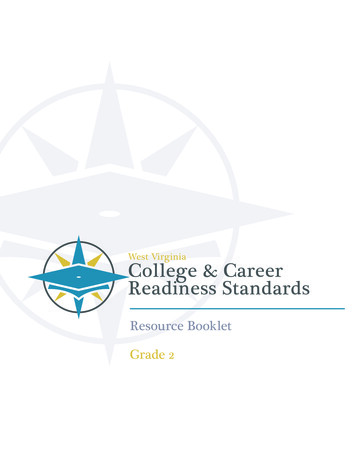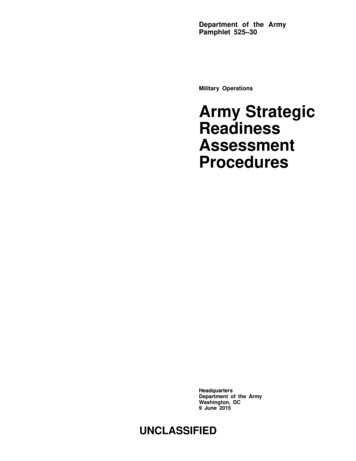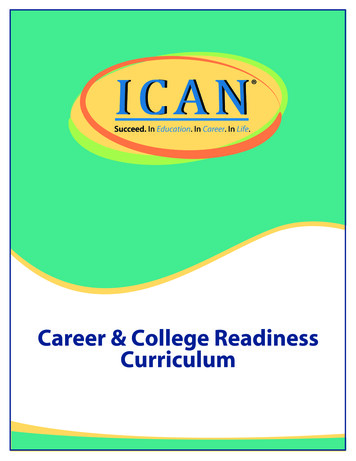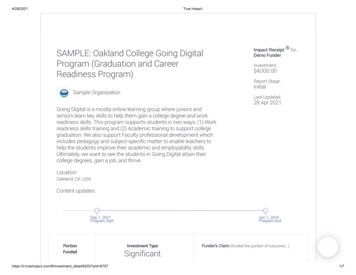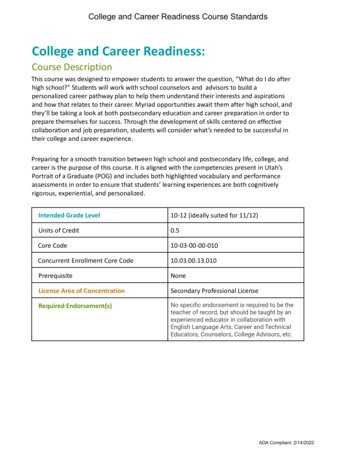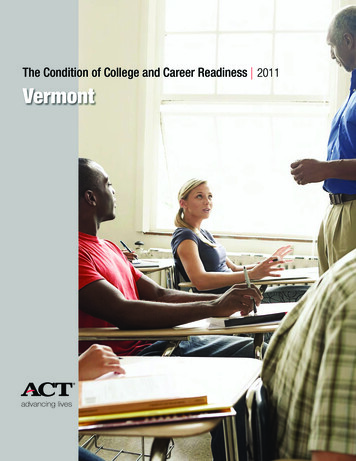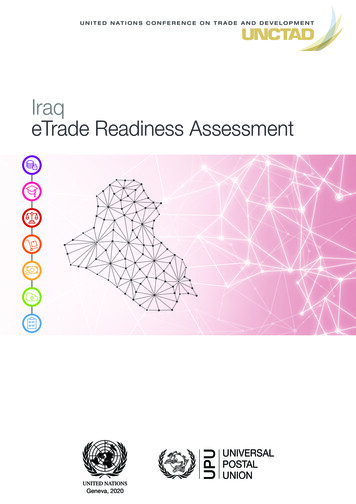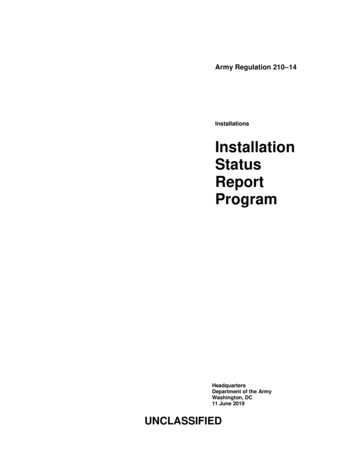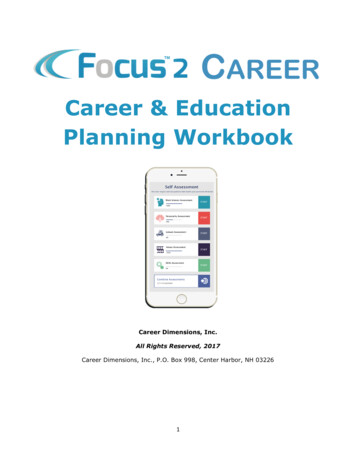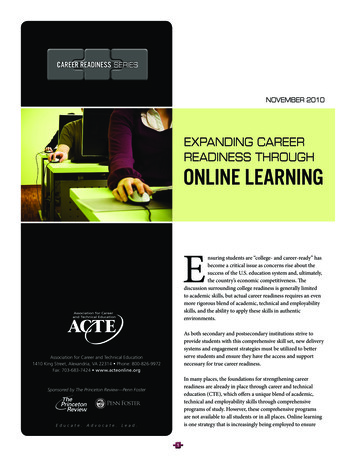
Transcription
CAREER READINESS SERIESNOVEMBER 2010EXPANDING CAREERREADINESS THROUGHONLINE LEARNINGEnsuring students are “college- and career-ready” hasbecome a critical issue as concerns rise about thesuccess of the U.S. education system and, ultimately,the country’s economic competitiveness. Thediscussion surrounding college readiness is generally limitedto academic skills, but actual career readiness requires an evenmore rigorous blend of academic, technical and employabilityskills, and the ability to apply these skills in authenticenvironments.As both secondary and postsecondary institutions strive toprovide students with this comprehensive skill set, new deliverysystems and engagement strategies must be utilized to betterserve students and ensure they have the access and supportnecessary for true career readiness.Association for Career and Technical Education1410 King Street, Alexandria, VA 22314 Phone: 800-826-9972Fax: 703-683-7424 www.acteonline.orgIn many places, the foundations for strengthening careerreadiness are already in place through career and technicaleducation (CTE), which offers a unique blend of academic,technical and employability skills through comprehensiveprograms of study. However, these comprehensive programsare not available to all students or in all places. Online learningis one strategy that is increasingly being employed to ensureSponsored by The Princeton Review—Penn FosterEd u cat e .Ad vo ca t e .Le a d .1
students have access to high-quality CTE programs and thenecessary skills to be successful in the 21st century workplace.Most importantly, online learning canprovide students with a comprehensive setof academic, employability and technicalskills to ensure career readiness.While online learning, in some form, has been in place sincethe 1960s1, its overall use and scale have exploded in recentyears. Over the past decade, online learning has experiencedsignificant growth at all levels of education. The number ofelementary and secondary students taking online coursesincreased tenfold between 2001 and 2007, from about 200,000to almost 2 million, and projections estimate the numbercould reach well over 2 million by 2012.2 The InnosightInstitute predicts that in less than 10 years, 50 percent of thenation’s secondary courses will be taken over the Internet.3Furthermore, in 2009, nearly 12 million U.S. postsecondarystudents took some or all of their classes online. This number isexpected to jump to more than 22 million in the next five years.4and lifelong learning opportunities; and provides moreindividualized learning experiences. Most importantly, onlinelearning can provide students with a comprehensive set ofacademic, employability and technical skills to ensure careerreadiness.DELIVERY OF ONLINE LEARNINGThe reasons for this growth are varied—online learning helpsprovide access to course material that students might nototherwise have, especially in rural areas; allows working adultsto more conveniently engage in postsecondary educationOnline courses can be structured in various ways to deliverthese skills. At both the secondary and postsecondarylevels, courses can be offered completely online, deliveringAt Northern Virginia Community College(NOVA), online courses are designed tooffer flexible and convenient access to higher education. Thesecourses are largely administered through NOVA’s ExtendedLearning Institute (ELI), with some courses also offeredthrough individual NOVA campuses.In addition to individual courses, NOVA offers 13 completedegree programs through ELI, including an Associate ofApplied Science in Accounting, an Associate of Sciencein Business Administration and an Associate of Science inInformation Technology. ELI also offers certificate programsin both Bookkeeping and Small Business Management. Inaddition to these programs, ELI offers five career studiescertificates in Accounting, Business Management Principles,Business Information Technology, Desktop Publishing andLeadership Development. Courses in these programs aredesigned to prepare students for immediate work placement,as well as for continuing studies at four-year institutions.Online courses largely utilize asynchronous Web-basedinstruction through the content-management systemBlackboard; however, a growing number of courses nowutilize eNOVA, NOVA’s online, real-time student learningenvironment. eNOVA allows students to interact with facultyand other students by providing real-time two-way audio,application sharing, Web browsing, white-boarding and textchatting. In addition, many courses also use synchronous andasynchronous video technology.NOVA’s online programs have provided a number of diverseindividuals the opportunity to pursue degrees that would haveotherwise been impossible through traditional courses. Forexample, the flexibility of online courses has allowed militarypersonnel to continue their education despite reassignmentsor deployments. Students in rural areas, often limitededucationally due to distance and cost, have completeddegrees and accessed courses they otherwise could not attend.Stay-at-home parents that cannot afford child care have beenable to pursue a degree while still taking care of their children,and busy professionals are able to pursue a degree whilemaintaining their hectic schedules.NOVA offers a number of CTE-related online courses, including Intro to Engineering, Basic Electric Circuits, Health Information Systems, General Pharmacology, Web Design and Database Management. In addition, NOVA also offers CTE-relatedhybrid courses, such as Veterinary Technology and Nursing,which usually consist of 50 percent face-to-face or classroomtime and 50 percent online activities. Examinations for onlinecourses are usually taken at NOVA campus testing centers.2
all instruction through online media, or through a hybridapproach that blends online learning with class time, labwork or other face-to-face interactions. The same is true ofentire programs. Some degree and certificate programs at thepostsecondary level are offered completely online, and someelementary and secondary school students attend “virtualschools” full time, while other students may enroll in only onecourse that utilizes online learning.In Pennsylvania, Seneca Valley SchoolDistrict’s new online education programprovides students with a hands-on learning experiencethat benefits both students who excel academically andthose who struggle in a traditional classroom environment.According to Superintendent Don Tylinski, the overall goalof the program is to provide students “a perfect fit” fortheir academic interests and abilities and to translate thoseinterests and abilities into a successful job. The programgives students a wide range of academic options: Studentscan take core classes, such as math, biology, historyand English, as well as electives, such as art, economics,personal finance, Mandarin Chinese and a range of CTEcourses.Online learning also has a variety of applications. At thepostsecondary level, online learning is offered in credit, noncredit and employer-sponsored courses and programs.5 It is alsoavailable to students in elementary, middle and high schoolsacross the full range of subjects that comprise the curriculum,and is used for regular instruction, credit recovery andenrichment.6Within the online program, students not only earn creditfor graduation, but also can earn an industry-recognizedcertification through CTE courses delivered by Penn Foster.Students in the online CTE courses can participate in abusiness co-op program, which allows them to completetheory work online and then be released from school towork at a related job to receive hands-on training. A widevariety of program options are available within the SenecaValley/Penn Foster partnership. For example, studentscan prepare for careers as locksmiths, diesel mechanics,veterinary assistants and auto mechanics. The district hasalso developed an extensive “materials library,” whichallows students immediate access to needed resources forcoursework and training.Online learning has the ability to benefitstudents who might not otherwise haveaccess to educational programs providingall of these skills—and offers quality equalto or exceeding that of traditionalface-to-face instruction.In addition to providing more academic choices forstudents, district officials hope the non-traditional, handson learning keeps potential dropouts in school, as well asentices home-schooled or other students who participatein other online schools back into the Seneca Valley district.At the same time, the long-term goal, according toassistant superintendent Matt McKinley, is that the onlineprogram will also be used to serve the local communityat large by providing courses for adults wishing to obtainmore education or earn a certification. As such, courseswithin the online program will be tailored to meet theneeds of local businesses and industries and provide themeans to educate and train a career-ready local workforce.In addition, both fully online and hybrid courses utilizeasynchronous and synchronous delivery components.Asynchronous components communicate course contentthrough Web pages, e-mail, discussion boards, PowerPointpresentations, interactive Flash modules and other multimediaprograms. Synchronous components, such as Web-based chatsor voice communications, allow students to meet online at thesame time and interact with their instructor and each other.7While some online courses are developed by individualinstructors, educational institutions or school districts, otherschools utilize online learning educational partnerships for thedelivery of these programs. These partnerships can be especiallyvaluable for small and rural schools and help overcome theprohibitive costs that can be involved in development andmaintenance of high-quality online learning opportunities.These partnerships might include work with a public statewidevirtual school or an independent vendor. Online learningThe online program has experienced significant growthsince it began in the summer of 2008. Starting with onlyfour students, the program grew to nearly 45 studentsduring the 2009-2010 school year. Enrollment nearlydoubled for the 2010-2011 school year, growing to nearly90 students attending either part time or full time.3
vendors provide rigorous course content for both core classesand electives, hard copies of curriculum resources, tests andother assessment materials, and customer and tech support foradministrators, teachers, students and parents. They also mayfacilitate instruction and provide training for in-house teachers.working and paying taxes, buying homes, supporting families,and other responsibilities associated with the everyday roleof a full-time citizen.”12 By giving them the flexibility of time,location and courses offered, online programs provide theseindividuals with the freedom to pursue their educations whilecontinuing with their current jobs and responsibilities.13At the K-12 level, positive results for online learning have beenfound across a number of research studies. Online courses havebeen shown to effectively educate students in both accelerationand credit recovery programs,14 to be effective in educatingstudents with physical and learning disabilities,15 and to narrowthe state testing achievement gap for those in economicallydisadvantaged subgroups.16 The Missouri Department ofEducation found that, in many cases, “students who failed theirrequired high school courses in traditional schools passedonline courses based on the same standards.”17The technologies involved in onlinelearning are directly aligned to the real-worldlives of students in the 21st century—making education more relevant to theireveryday existence.In online learning, students are no longer restricted to locallyavailable courses and programs. This is particularly beneficialto rural students who might not otherwise have access tospecialized courses that can enhance their career readiness.Research has shown that many of the students enrolled inonline and distance courses offered by community collegeslive “outside the boundaries of the state where the collegeresides.”18 Such flexibility also benefits educational institutionsby allowing them to expand their enrollment without investingin new physical infrastructure.BENEFITS OF ONLINE LEARNINGIn order for students to be truly ready for careers, they musthave access to educational opportunities that provide academic,employability and technical skills. Online learning has theability to benefit students who might not otherwise have accessto educational programs providing all of these skills—and offersquality equal to or exceeding that of traditional face-to-faceinstruction. Its instructional strategies also have the potentialto dramatically benefit students with a wide variety of learningstyles.According to a recent U.S. Department of Education metaanalysis of online education research, “On average, studentsin online learning conditions performed modestly betterthan those receiving face-to-face instruction.”8 This findingis true at both the secondary and postsecondary levels. Atthe postsecondary level, student achievement in onlinecourses has repeatedly been shown to equal achievementof on-campus students.9 At the K-12 level, as the Center forAmerican Progress reported, “student academic performancein well-designed online courses is on average equivalent toperformance in high-quality classroom-based courses.”10Furthermore, the National Center for Education Statisticsclaimed that “Distance education [which includes onlineeducation] is just as effective as traditional education in regardto learner outcomes.”11Many people only associate onlinelearning with providing academic skills,but, as technology has advanced, theconnection to technical and employabilityskill sets is also growing, especiallythrough CTE programs.The use of technology in online learning has numerous benefitsfor both students and teachers. As noted in a New York Timesarticle, the real promise of online education is in “providinglearning experiences that are more tailored to individualstudents than is possible in classrooms.”19 Multimedia andHTML tools can be used to create unique and relevant coursecontent that engages multiple learning styles. Teachers andAt the postsecondary level, online learning can be particularlybeneficial for non-traditional students, many whom areadults who are “citizen-students,” or students “concerned with4
students can utilize e-mail, chat rooms and discussion boardsto build real-time collaborative learning environments, whichallow for more active participation and interaction and buildrelevant collaboration skills. Web-based learning also putsstudents directly in touch with a greater breadth of informationabout course topics. The technologies involved in onlinelearning are directly aligned to the real-world lives of studentsin the 21st century—making education more relevant to theireveryday existence.At Auburn Career Center in ConcordTownship, Ohio, online courses serveseveral important purposes. For one, they are a meansto expand instruction without infringing upon CTE classtime. As such, the online program provides Auburn withthe opportunity to better prepare students for the rigorsof collegiate study by developing students’ independentlearning and time-management skills. Also, online coursesprepare students for the educational programs and skillsneeds of the future. With projections that 50 percent ofall students will be taking online courses within 10 yearsand with the prevalence of online certification testing,administrators at Auburn feel that online education “is thelearning option for the future” and is “a technology skillour students need reinforced.”36A study by the University of Alabama found that teachersalso benefit from using online course-management systemsby being able to spend more time on advanced material andincrease student engagement.20 The flexibility and change ofpace offered by online courses can provide the opportunity forteachers to inject fresh ideas into the delivery of their coursecontent. As a result, veteran teachers can find a renewed senseof vigor by trying new teaching activities. At the same time,the promise of teaching online courses is a way to recruitnew, young teachers, as teaching online courses allows themcreativity within their course content through the cuttingedge, Web-based technologies with which they are familiar. Inaddition to revitalizing teaching methodologies, the promisingresults of online education also provide a renewed sense ofoptimism about student performance.21Auburn structures its course offerings into Career Pathwaycategories. Students take courses to earn career certificationin such fields as Alternative Energy Technology, AutomotiveTechnology, Culinary Arts, Cosmetology and Pharmacy Techin partnership with Penn Foster. Auburn uses Blackboard asits learning-management system and built its own coursesthrough a consortium partnership with several local schooldistricts. Within these online courses, several delivery stylesare utilized, such as independent online learning, resourceand remote classrooms, and team learning environments.ONLINE LEARNING IN CTESuccess of the online program at Auburn is attributed tothe ongoing professional development and teacher support.Online instructors at Auburn have found helpful the regularcollaborative, hands-on training, as well as the one-to-oneand face-to-face technical assistance and instructionalsupport.Many people only associate online learning with providingacademic skills, but, as technology has advanced, theconnection to technical and employability skill sets is alsogrowing, especially through CTE programs. A recent studyfrom the National Research Center for CTE (NRCCTE) foundthat 47.5 percent of community colleges offered credit-grantingonline occupational programs with at least 50 percent ofcourse content online; previous studies have shown that overthree-quarters offer individual courses online.22 While an exactnumber of secondary students participating in online CTEcourses is not available, anecdotal evidence suggests that theseofferings are growing.Overall, Auburn has found many strong advantages toonline education, according to Jeffrey Butler, director ofbusiness development. These advantages include: providing course continuity for absent students,teachers or substitute teachers automatic access to tutorials unlimited student access to reviewcontent prior to testing compatibility with traditional scheduling greater facilitation of differentiated instructionand exponential learning complete courses prepared for new teachers the possibility of virtual field trips the ability to foster multisensory learning customizable content for students’ learning stylesOnline learning opportunities are offered across all 16 careerclusters within CTE, but are more common in technologyrich career fields like business, information technology andhealth informatics.23 For example, the Utah Electronic HighSchool offers secondary students online courses in Web design,computer programming and business law,24 while the KentuckyVirtual Schools also offer video game design and healthscience.255
Online CTE courses utilize a number of different and effectiveinstructional methods and often take advantage of the hybridapproach to online learning. One method is “on-campus skillacquisition.” In this model, class work, lectures and mosthomework assignments are covered by the online portion ofthe class. However, students are still required to “complete alaboratory course on campus to acquire their hands-on skilltraining, as are the campus-based students.”26 One exampleof this is the emergency medical technician program at IowaWestern Community College, which provides an option forstudents to complete all lectures, assignments, quizzes andexams online, but includes 32 hours of skills-based lab workthat must also be completed by students on campus during theprogram.27online program that can be used by teachers to improve studentskills in areas like communications, ethics, conflict resolution,teamwork, time management, goal-setting and culturaldiversity. These materials can be integrated into an existingcourse or used independently. 31All of these opportunities for online learning in CTE can helpto expose students to the full range of career-readiness skillsthrough convenient, innovative approaches.When it comes to measurable outcomesof online CTE courses, one study showedthat, like in online education generally,at minimum, there is no difference betweenthe student achievement measures ofonline and on-campus students.Another method involves internships or clinical experiences.Like the on-campus method, most of the coursework iscompleted online; however, to gain hands-on experience,students serve as an apprentice or student intern in a worksetting. To prove their competency, students provide evidenceof their acquired skills by submitting samples of their work totheir instructor.28In rural South Dakota, access to coursework and careerreadiness experiences can be a challenge. However, throughthe DIAL Virtual School,29 part of the South Dakota VirtualHigh School, a Youth Internship course is offered to studentswho may not be able to participate at their home high school.Students in the course spend time at a business, non-profitorganization or government agency to increase their knowledgeof workplace skills and receive on-the-job experience.Through the online interface, students also explore careers andeducational opportunities, create resumes and portfolios andstrengthen their ability to apply reading, communication andmath skills in authentic career-related activities.BENEFITS OF ONLINE LEARNING IN CTEUsing online learning courses in CTE programs yields anumber of specific benefits in addition to those alreadydiscussed. For example, the flexibility of online CTE coursesyields an effective strategy to “attract a critical mass of studentsto specific skill areas that are currently under-enrolled or tofields where there is high demand for new employees, [as]lifting the distance barrier of on-campus courses opens theprogram to a new and previously inaccessible pool of studentcandidates.”32The use of online learning in CTE can also reduce schedulingconflicts that often emerge for students. Providing onlineoptions that can be accessed after the traditional school day canfree up student time for core academic requirements or otherelectives, or for intensive blocks of CTE, such as internshipsor other work-based learning opportunities. The lack of a timeconstraint allows students to more fully develop all three skillsets involved in career readiness without having to sacrifice in aspecific area.In addition to these hybrid models, specific CTE courseelements, such as virtual job shadowing, are often offeredonline to enrich core curriculum. Computer-based simulationsare also becoming more prevalent. This method uses computersimulation software, which allows students to apply their skillsin a controlled environment without the danger or cost of a“real-life” situation. Simulation software is used in such areasas landscape architecture, firefighting techniques, electricaltroubleshooting, off-highway truck driving and manufacturingprocesses.30When it comes to measurable outcomes of online CTE courses,one study showed that, like in online education generally,at minimum, there is no difference between the studentTo strengthen students employability skills, the career andtechnical student organization SkillsUSA has developed a fully6
NEXT STEPSachievement measures of online and on-campus students.33 Anumber of other studies confirm these findings.34While online learning is clearly growing, expanding into neweducation environments and providing strong benefits tostudents, more needs to be done to realize the full potential thatthis delivery system has to offer to students’ career readiness.Policymakers and education leaders should take these stepsto ensure that all students have access to high-quality onlinelearning that includes academic, technical and employabilityskills:This has also proven to be true in the areas of both technicalskills and employability skills. The NRCCTE found that onlineCTE courses are an effective way for students to preparefor national board examinations. Specifically, it found that,when an online curriculum was closely aligned with state andnational licensing standards, “students who completed theonline courses were successful, on the first attempt, in passingthe national board exam for their regulated profession.”35Further, a recent study of baccalaureate nursing studentssuggests that online CTE courses can significantly contributeto the “soft” skills of students. The study found “a significantdifference between online and face-to-face students in theirdegree of ‘enculturation’ or socialization into the field ofnursing,” as the online students had higher socialization scoresthan the campus-based nursing students.37 Ensure adequate resources to expand the number ofschools offering CTE options within online learningprograms so the full range of career-readiness skillsare addressed, and to support the hardware, softwareand broadband needs of these programs, especiallyin rural areas. Expand course development to ensure studentscan complete entire sequences of courses withincomprehensive programs of study through onlinelearning.As the number of online CTE courses and students continuesto grow, the technologies involved are also being expanded.As the NRCCTE reports, in general, future courses “will seeexpanded use of course management systems, asynchronousdiscussion technologies, CD-ROM/DVD for the delivery ofcourse content, and streaming media for delivery of live orrecorded audio and video.”38 Several specific developmentsinclude the use of multimedia and real-time exchanges of voiceand images, such as synchronizing PowerPoint presentationswith streamed audio and video, the use of real-time voice chat,and desktop videoconferencing. All of the new technologiesand delivery methods will further benefit students and increasethe number and diversity of programs that can incorporateonline learning. Provide more high-quality professional developmentfor those who teach online courses in order to ensurerigorous content and student success in this uniquelearning environment. Continue to improve the integration of online andface-to-face or hands-on learning, which has resultedin the highest student achievement results and allowscontinued expansion in the number of subject areasoffered through online learning.7
REFERENCES123456789101112131415161718Woolley, David, “PLATO: The Emergence of Online to.htm.Picciano, Anthony and Jeffery Seaman, “K-12 Online Learning: ASurvey of U.S. School Administrators” (Needham, MA: SloanConsortium, 2007).Brown, Emily, “Bolster Accreditation for Virtual Schools, Experts Say,”Education Daily, June 25, 2010.Adkins, Sam, “US Self-paced eLearning Market,” Ambient Insight,October 2009.Githens, Rod, Fashaad Crawford and Timothy Sauer, OnlineOccupational Education in Community Colleges: Prevalence andContextual Factors (Louisville, KY: National Research Center for Careerand Technical Education, University of Louisville, 2010).Picciano and Seaman, “K-12 Online Learning: A Survey of U.S. SchoolAdministrators.”Hrastinski, Stefan, “Asynchronous and Synchronous E-Learning,”EDUCAUSE Quarterly 31, no. 4 (October–December 2008).Means, Barbara, Yukie Toyama, Robert Murphy, Marianne Bakia andKarla Jones, Evaluation of Evidence-Based Practices in Online Learning:A Meta-Analysis and Review of Online Learning Studies (Washington,DC: U.S. Department of Education, Office of Planning, Evaluation, andPolicy Development, 2010), p. ix.Russell, Thomas, The No Significant Difference Phenomenon(Montgomery, AL: International Distance Education CertificationCenter, 1999).Cavanaugh, Cathy, “Getting Students More Learning Time Online:Distance Education in Support of Expanded Learning Time in K-12Schools” (Washington, DC: Center for American Progress, 2009), p. 3.U.S. Department of Education, Institute of Education Sciences, NationalCenter for Education Statistics, Distance Education at PostsecondaryEducation Institutions: 1997–1998 (Washington, DC: U.S. GovernmentPrinting Office, 2000), p. 6.Vaughan, George, The Community College Story, 2nd ed. (Washington,DC: Community College Press, 2000), p. 14.Brown, Bettina, “Web-Based Training,” ERIC Document ReproductionService No. ED445234, 2000.Watson, John and Bruce Gemin, “Using Online Learning for At-RiskStudents and Credit Recovery” (Washington, DC: International Councilfor K-12 Online Learning, 2008).Rose, Raymond and Robert Blomeyer, “Access and Equity in OnlineClasses and Virtual Schools” (Washington, DC: International Councilfor K-12 Online Learning, 2007).WestEd, “Evaluating Online Learning: Challenges and Strategies forSuccess” (U.S. Department of Education, 2008).Cavanaugh, “Getting Students More Learning Time Online:Distance Education in Support of Expanded Learning Time in K-12Schools,” p. 3.Benson, Angela, Scott Johnson, Gail Taylor, Tod Treat, Olga Shinkarevaand John Duncan, Distance Learning in Postsecondary Career andTechnical Education: A Comparison of Achievement in Online vs. OnCampus CTE Courses (St. Paul, MN: National Research Center forCareer and Technical Education, 2004), p. 55.Association for Career and Technical Education1410 King Street, Alexandria, VA 22314Phone: 800-826-9972 Fax: 703-683-7424www.acteonline.org Educate. Advocate. Lead.19 “Study Finds That Online Education Beats the Classroom,” New YorkTimes, August 19, 2009, ds-that-online-education-beats-the-classroom20 Harrington, Terrance, Marilyn Staffo and Vivian Wrig
and English, as well as electives, such as art, economics, personal finance, Mandarin Chinese and a range of CTE courses. Within the online program, students not only earn credit for graduation, but also can earn an industry-recognized certification through CTE courses delivered by Penn Foster. Students in the online CTE courses can participate .
